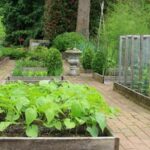Are you interested in growing your own organic vegetables but don’t have access to an outdoor garden space? Indoor organic vegetable gardening might be the perfect solution for you.
With the right location, containers, and knowledge of how to create a healthy environment for your plants, you can enjoy a bountiful harvest of fresh and nutritious produce right in your own home. In this article, we will explore the many benefits of indoor organic vegetable gardening and provide you with the information you need to get started on your own indoor garden.
Indoor organic vegetable gardening allows you to have complete control over the growing conditions of your plants, ensuring that they are free from harmful chemicals and pesticides. This not only provides you with a sustainable source of fresh produce but also contributes to a healthier and more environmentally friendly lifestyle. By growing your own organic vegetables indoors, you can reduce your carbon footprint and minimize food wastage while enjoying the satisfaction of nurturing your own plants from seed to harvest.
In addition to being a sustainable practice, indoor organic vegetable gardening also offers the convenience of having fresh produce readily available at home. Whether you live in a small apartment or a house with limited outdoor space, indoor gardening allows you to grow a variety of organic vegetables year-round without being dependent on external factors such as weather or soil quality.
With the right knowledge and techniques, indoor gardening can be a rewarding and fulfilling hobby that brings nature into your living space.
Getting Started
When beginning your indoor organic vegetable garden, one of the crucial elements to consider is choosing the right location and containers for your plants. The first factor to keep in mind is light. Selecting a spot near a window where your plants will receive adequate sunlight is essential. If you have limited natural light, you may need to invest in grow lights to ensure your vegetables get enough light to thrive.
In addition to light, it’s important to consider the temperature of the location. Most vegetables prefer temperatures between 65-75°F (18-24°C), so be mindful of placing your indoor garden away from drafts or extreme temperature fluctuations.
Next, choose suitable containers for your plants. Containers should have sufficient drainage holes to prevent waterlogged soil, and be large enough for the plant’s roots to spread out comfortably. Options for containers include plastic or terracotta pots, fabric grow bags, or even repurposed containers such as buckets or storage bins.
Furthermore, consider the space available for your indoor garden. If you have limited space, vertical gardening with options like hanging planters or wall-mounted shelves can maximize the use of space while still providing room for an abundant variety of vegetables to grow. It’s also important to take into consideration accessibility for watering and maintenance when choosing the location and containers for your indoor organic vegetable garden.
Selecting the Best Organic Vegetables to Grow Indoors
When it comes to indoor organic vegetable gardening, it’s essential to choose the right vegetables that will thrive in a controlled indoor environment. Some vegetables are more well-suited for indoor growing than others, and selecting the best ones will ensure a successful and bountiful indoor garden.
One of the top picks for indoor organic vegetable gardening is herbs such as basil, cilantro, and mint. These herbs don’t require a lot of space and can flourish indoors with the right amount of sunlight and water. Leafy greens like lettuce, spinach, and kale are also excellent choices for indoor gardening due to their compact size and relatively low maintenance requirements.
Additionally, root vegetables like radishes and carrots can be grown in large containers or deep pots indoors. These vegetables do well in loose soil with good drainage, making them ideal for indoor gardening. Some compact varieties of tomatoes and peppers can also be successfully grown indoors if they receive enough sunlight and proper care.
Overall, selecting the best organic vegetables for indoor gardening involves considering their space requirements, light exposure needs, and maintenance demands to ensure a thriving indoor garden. By choosing the right vegetables for your indoor space, you can enjoy a bountiful harvest of fresh, organically-grown produce right from your home.
Soil and Fertilizer
When it comes to successful indoor organic vegetable gardening, creating a healthy environment for your plants starts with the soil and fertilizer you use. In this section, we will explore the importance of quality soil and organic fertilizers in ensuring the success of your indoor garden.
Choosing the Right Soil
The foundation of a thriving indoor organic vegetable garden is the soil in which your plants will grow. Look for high-quality, organic potting mix that is specifically formulated for vegetables. This type of soil provides essential nutrients and promotes good drainage, which is crucial for preventing waterlogged roots.
Organic Fertilizers
In addition to choosing the right soil, using organic fertilizer is key to providing essential nutrients to your indoor plants. Organic fertilizers are derived from natural sources and help improve soil structure while promoting beneficial microbial activity. When selecting an organic fertilizer, look for options that are specifically designed for vegetable gardens and follow the recommended application instructions.
Composting
Consider starting a small composting bin to create nutrient-rich compost for your indoor garden. Compost adds valuable organic matter to the soil, improves moisture retention, and provides a slow release of essential nutrients. By composting kitchen scraps and plant material, you can reduce waste while providing your indoor vegetables with a sustainable source of nutrition.
By focusing on quality soil and organic fertilizers, you can ensure that your indoor organic vegetable gardening efforts are off to a healthy start. With the right foundation in place, your plants will have everything they need to thrive and provide you with an abundant harvest of fresh, nutritious vegetables.
Watering and Sunlight Requirements for Indoor Organic Vegetable Gardening
Watering Your Indoor Garden
When it comes to indoor organic vegetable gardening, watering is a crucial aspect of maintaining a healthy and thriving garden. Different vegetables have different water needs, so it’s important to research the specific requirements of the vegetables you plan to grow. Generally, most vegetables require consistent moisture, but it’s essential to avoid overwatering, which can lead to root rot and other issues.
One helpful tip for watering your indoor garden is to invest in a good quality watering can with a narrow spout. This will allow you to water the soil directly without splashing water onto the leaves, which could lead to mold or disease. Additionally, using room temperature water can help prevent shocking the plants.
Sunlight Requirements
While most vegetables thrive in full sun outdoors, indoor organic vegetable gardening presents some challenges when it comes to providing adequate sunlight. It’s important to place your indoor garden in a location that receives at least 6-8 hours of direct sunlight per day. If natural light is limited in your home, supplemental grow lights can be used to ensure that your vegetables receive the appropriate amount of light for healthy growth.
It’s crucial to monitor your plants closely and adjust their position as needed to maximize their exposure to sunlight. Rotating the containers regularly can help promote even growth and prevent leggy or lopsided plants. By paying close attention to the sunlight requirements of your indoor garden, you can ensure that your vegetables thrive and produce an abundant harvest.
Overall, understanding the specific watering and sunlight needs of the vegetables you choose to grow indoors is essential for successful indoor organic vegetable gardening. With proper care and attention to these requirements, you can enjoy a bountiful harvest of fresh, organic produce right from your own home.
Pest Control and Disease Prevention for Indoor Plants
Pests and diseases can be a challenge for indoor organic vegetable gardening, but with the right knowledge and strategies, you can prevent and control them effectively. One of the best ways to prevent pests and diseases is by starting with healthy plants. Make sure to purchase your seeds or seedlings from reputable sources, ensuring that they are disease-free.
Another important aspect of pest control and disease prevention is maintaining a clean environment for your indoor garden. Regularly remove any dead leaves or plant debris, as these can attract pests and harbor diseases. Additionally, regularly inspect your plants for any signs of pests or diseases, such as holes in the leaves or discoloration.
When it comes to organic pest control, there are several natural methods you can use to keep your indoor garden healthy. For example, introducing beneficial insects like ladybugs or lacewings can help control pests such as aphids or spider mites. You can also create homemade organic insecticidal soaps using ingredients like neem oil or garlic to deter common pests.
Furthermore, proper air circulation and watering practices can also contribute to preventing diseases in your indoor garden. Avoid overwatering your plants, as this can lead to fungal issues, and ensure that there is adequate airflow around your plants to discourage the development of mold and mildew.
| Aspect | Recommendation |
|---|---|
| Starting with Healthy Plants | Purchase disease-free seeds or seedlings from reputable sources. |
| Maintaining a Clean Environment | Regularly remove dead leaves or plant debris to prevent attracting pests. |
| Organic Pest Control | Introduce beneficial insects like ladybugs or use homemade organic insecticidal soaps. |
Harvesting and Enjoying the Fruits of Your Indoor Garden
Now that you have put in the time and effort into your indoor organic vegetable gardening, it is time to reap the rewards. Harvesting your vegetables at the right time ensures that they are at their peak flavor and nutrition. Here are some tips for harvesting and enjoying the fruits of your indoor garden:
1. Timing is everything: It is important to harvest your vegetables at the right time to ensure optimal flavor and nutrition. Research the specific vegetables you are growing to determine when they are ready for harvesting. For example, leafy greens like lettuce and spinach are best harvested when they are young and tender, while root vegetables like carrots and beets should be harvested when they have reached a good size.
2. Enjoying your harvest: There is nothing quite as satisfying as enjoying a meal made with produce from your own indoor organic vegetable garden. Whether it’s a fresh salad with your homegrown lettuce or a stir-fry with your own peppers and tomatoes, savoring the fruits of your labor is one of the greatest joys of gardening.
3. Sharing with others: If you find yourself with an abundance of produce from your indoor garden, consider sharing it with friends, family, or neighbors. Not only will you spread the joy of homegrown vegetables, but you will also foster a sense of community and connection through sharing your harvest.
By following these tips, you can make the most out of your indoor organic vegetable gardening efforts and enjoy delicious, nutritious produce from the comfort of your own home.
Troubleshooting Common Issues in Indoor Organic Vegetable Gardening
When it comes to indoor organic vegetable gardening, there are a few common issues that may arise. Here are some troubleshooting tips to help you address these challenges and ensure that your indoor garden thrives:
1. Pests: Dealing with pesky pests is a common concern for indoor gardeners. To ward off insects and other unwanted creatures, consider implementing natural remedies such as neem oil or insecticidal soap. You can also introduce beneficial insects like ladybugs or predatory mites to help control pest populations.
2. Nutrient deficiencies: If you notice that your plants are showing signs of nutrient deficiencies, such as yellowing leaves or stunted growth, it may be time to adjust your fertilizer regimen. Consider using an organic, balanced fertilizer to provide essential nutrients for your plants.
3. Overwatering or underwatering: Finding the right balance when it comes to watering your indoor garden can be tricky. Overwatering can lead to root rot, while underwatering can cause wilting and stunted growth. Be sure to monitor the moisture levels in your soil regularly and adjust your watering schedule as needed.
Incorporating these troubleshooting tips into your indoor organic vegetable gardening routine can help you overcome common challenges and maintain a flourishing indoor garden. By staying attentive to the needs of your plants and making adjustments as necessary, you can enjoy a bountiful harvest of fresh, organic vegetables year-round.
Conclusion
In conclusion, indoor organic vegetable gardening offers numerous benefits for those looking to embrace a sustainable and healthy lifestyle. Not only does it provide a source of fresh, nutritious produce right at your fingertips, but it also allows you to reduce your carbon footprint by growing your own food at home.
The process of growing organic vegetables indoors can be both rewarding and fulfilling, as it gives individuals the opportunity to connect with nature and take control of what they consume.
By carefully selecting the right location and containers, choosing the best vegetables to grow indoors, and creating a healthy environment with the proper soil, fertilizer, watering, and sunlight requirements, anyone can successfully cultivate an indoor garden. Additionally, practicing pest control and disease prevention measures will ensure that your plants thrive and produce a bountiful harvest for you to enjoy.
Overall, indoor organic vegetable gardening is not only a sustainable and environmentally friendly practice but also promotes health and well-being. It’s an activity that can be enjoyed by individuals of all ages and provides a sense of accomplishment as you watch your plants grow and flourish.
So why not start your own indoor organic vegetable garden today? Not only will you be contributing to a healthier planet, but you’ll also be reaping the delicious rewards of your labor.
Frequently Asked Questions
How Do You Grow Organic Vegetables Indoors?
Growing organic vegetables indoors requires careful attention to lighting, temperature, and soil. It’s important to choose a container with good drainage and organic potting soil. Additionally, selecting the right vegetables for indoor growth is crucial.
What Vegetables Can You Grow Completely Indoors?
Many vegetables can be grown entirely indoors, including leafy greens like lettuce, kale, and spinach. Herbs such as basil, cilantro, and parsley also thrive in indoor environments. Certain root vegetables like radishes and carrots can be cultivated in containers as well.
Is an Indoor Vegetable Garden Worth It?
An indoor vegetable garden can be worth it for many people, especially those living in apartments or homes without outdoor gardening space. It provides a convenient source of fresh produce and can be a rewarding hobby. However, it requires commitment and attention to plant care to be successful.

If you’re looking to get into vegetable gardening, or are just looking for some tips on how to make your current garden better, then you’ve come to the right place! My name is Ethel and I have been gardening for years. In this blog, I’m going to share with you some of my best tips on how to create a successful vegetable garden.





